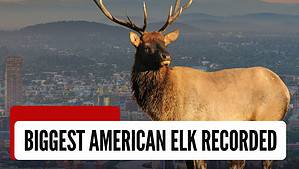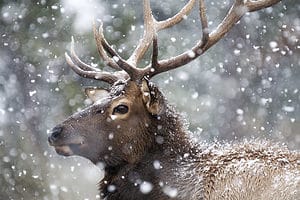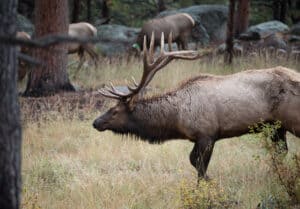Elk are one of the largest land-dwelling animals with only a few others standing taller than them. They are known by the large antlers grown by males as well as their distinctive call. These massive animals can weigh over 1,000 pounds and stand 5 feet tall at the shoulder, so they need a lot of energy to keep going. What foods do elk eat and how do they find them?
Those are fair questions given their size. We are going to explore the foods elk eat, how they continue finding food in adverse conditions, and the creatures that are big enough to hunt and take down an elk.
What Foods Do Elk Eat?
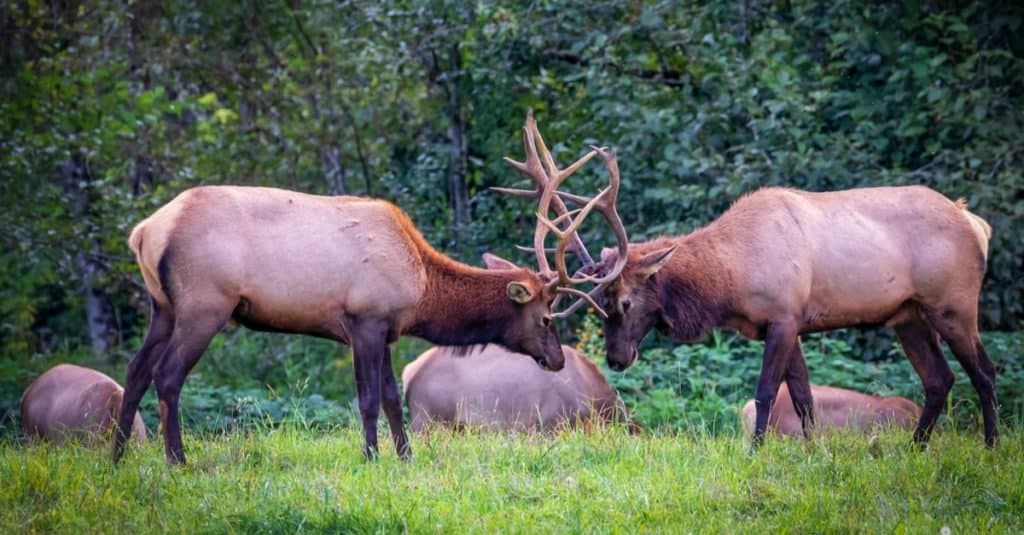
Elk are omnivores that
eat grasses
, tree bark, forbs, and even bird eggs!
©Mark A Lee/Shutterstock.com
Elk eat grasses, tree bark, and forbs for the vast majority of their diet. Although elk are almost exclusively herbivorous, a doctoral dissertation and recent home videos have shown elk consuming the eggs of small birds, the greater sage-grouse. Evidence has also shown that elk sometimes eat bones and antlers, too, most likely to supplement their diet. In any case, elk are actually omnivores.
Elk eat a lot of different foods throughout their lives, depending on what is available in their area. Here are some of the most common foods that elk will consume:
- Bluegrass
- Wheatgrass
- Fescue
- Timothy grass
- Dandelions
- Willow
- Elk thistle
- Violets
- Birch twigs
- Willow twigs
- Aspen twigs
- Rowan twigs
- Heather
- Lichen
- Bird bones
- Greater sage-grouse eggs
- Savannah sparrow
- Goslings
- White clover
- Acorns.
This list is a good overview of the different foods that elk eat when they have the opportunity. Their favorite foods, by far, are grasses. Since elk are ruminants, they have multi-chambered stomachs that allow them to digest tough materials like bark, twigs, and their favorite grasses. Elk regurgitate their food and chew the cud before swallowing it again as part of their digestive process.
Elk have been spotted eating far more foods in the extensive studies into their behavior and foraging habits, especially as the seasons change.
What Do Baby Elk Eat?
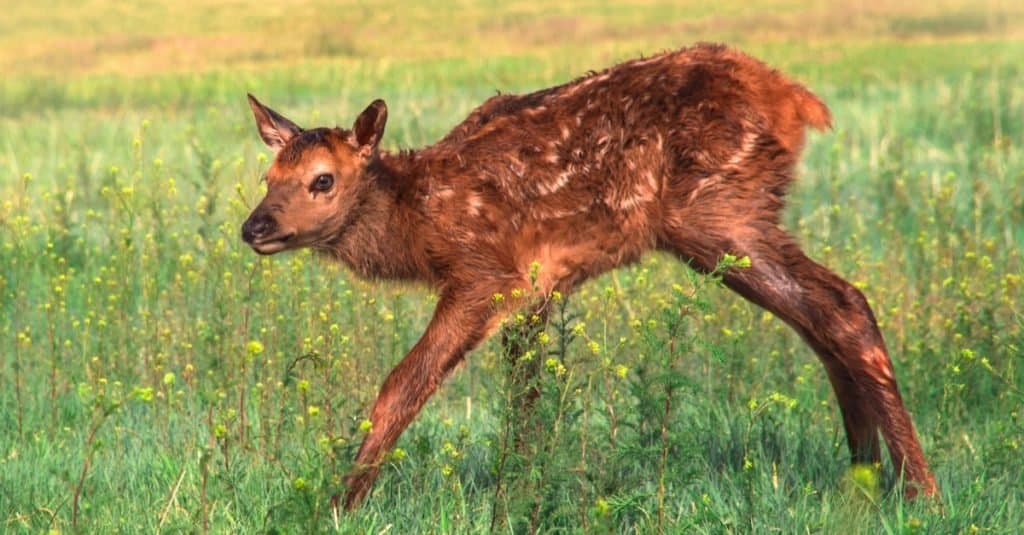
Elk calves drink milk for the first few weeks of their lives.
©Karlie Butler/Shutterstock.com
Baby elks are called calves, and they spend their early lives nursing milk from their mothers. For the first few weeks of their lives, calves exclusively feed on their mother’s milk. Less than a month later, calves begin to integrate grass into their diet.
They will continue to drink milk for 2-5 months after birth, during which time they introduce new foods into their diet. By the time they are a year old, they have assumed an adult elk’s complete diet.
How Much Do Elk Need to Eat?
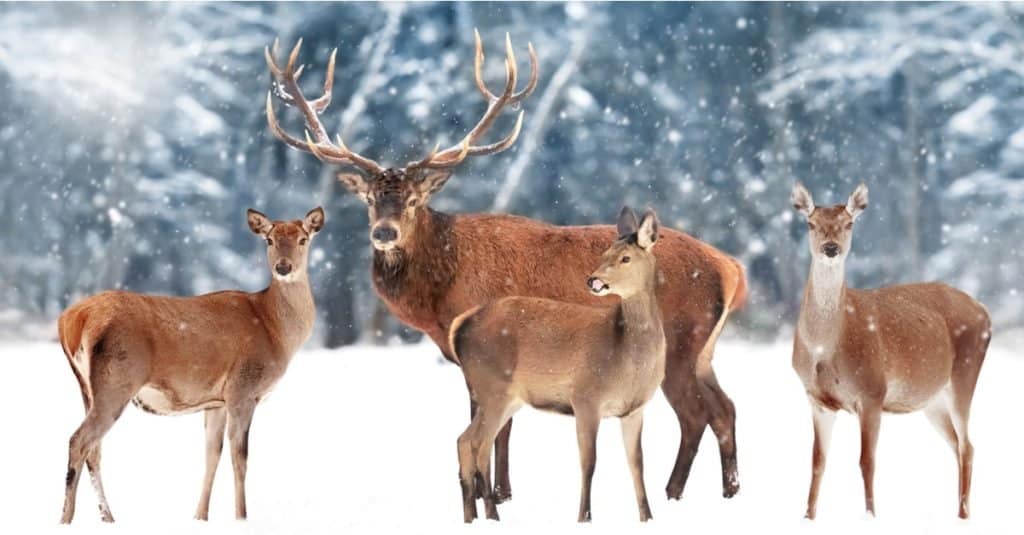
An elk needs to eat around 3 lbs for every 100 lbs it weighs.
©Delbars/Shutterstock.com
As we have already said, elk are massive creatures. Male elk, or bulls, can grow up to 5 feet tall and weigh 1,000 pounds. Female elk, called cows, can stand 4.5 feet tall at the shoulder and can reach weights of 600 pounds.
Since they are primarily herbivores, elk need to consume a lot of food to get the energy they need to travel, fend off predators, and forage.
The basic formula for determining how much elk need to eat on a daily basis is roughly 3 pounds for every 100 pounds that an elk weighs. A large cow will eat 18 pounds of forage while a large bull will eat nearly 30 pounds of food each day. That is a vast amount of food, and this fact explains why elk are constantly ranging in search of nutritious foods.
What Do Elk Eat in the Winter?
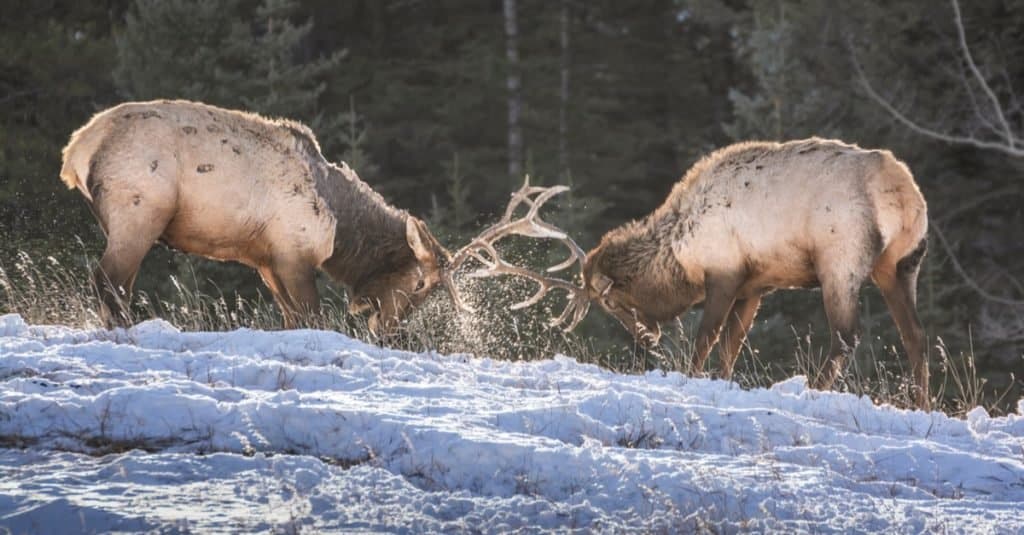
Elk can find most of their typical diet during the winter.
©James Gabbert/Shutterstock.com
The range of elk often brings them into areas that suffer intense winters. While elk are suited to survive in some dire situations, shedding their summer coat and growing a thicker, warmer winter coat. Unless the changes in winter are moderate, elk will often migrate to warmer lands.
Elk eat different foods at different times of the year based on what is available to them. Their range extends into mountainous areas where they can face severe winters, and their favored grasses, shrubs, and forbs won’t be as available then due to the deep snows.
Much of the food elk eat during the winter has a lower protein content than the summer foods and the food is less digestible. Nevertheless, they make do with foods that are not buried under snow, leaving them with:
- Less nutritious grasses
- Pine bark
- Aspen bark
- Pine needles
- Twigs from various trees
- Juniper
- Lichens
- Cattails.
These are the most common foods that elk will eat in the winter. Although nutritious food is harder to come by during this time, their unique stomachs allow them to get the nutrition they need. The lack of food might also explain some of their more unique food choices, like bits of bone and small birds.
What Predators Hunt Elk?
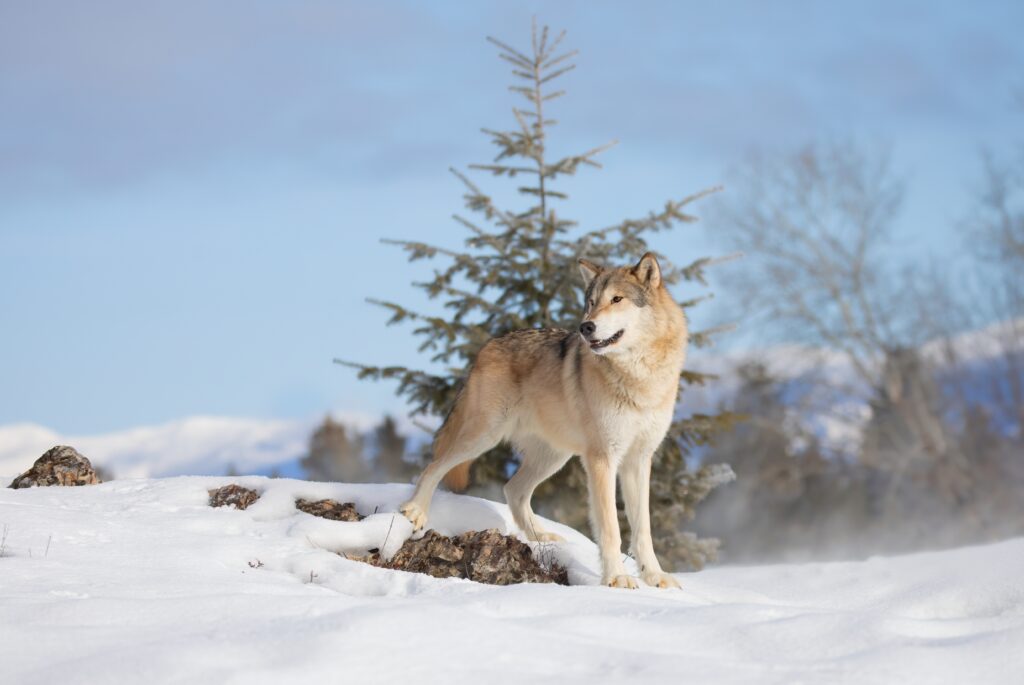
Wolves are the primary predator of elk.
©Jim Cumming/Shutterstock.com
Elk are very large creatures that possess a lot of power and antlers that can be used to kill other animals. They also contain a vast amount of muscle, so they make for an enticing meal for predators but not an easy one to bring down.
The predators that hunt elk are tough, and they include:
- Siberian tigers
- Coyotes
- Brown bears
- Cougars
- Mountain lions
- Gray wolves
- Black bears
- Bobcats
- Grizzly bear
- Humans.
Wolves are the most common killer of elk in many parts of the world, tracking them by smell and bringing them down as a pack. Human beings are also a common predator of elk, hunting them for sport and food, though the latter is not as common as other deer, another member of the Cervidae family.
Like other mammals, elk are most vulnerable when they’re young. While larger elk may scare off some predators, they can’t fend off packs of large, hungry animals or an especially daring bear.
Elk are large mammals that eat a lot of different foods, but they demonstrate a huge preference for grasses and anything they can eat in large volumes. Since they must eat so much, they are frequently on the move and grazing.
Although some people insist that they are entirely herbivorous, recent information and studies have shown they are omnivores. The topic will certainly be explored as more documented cases of them eating birds and their eggs become available.
Summary of What an Elk Eats
Here’s a recap of the foods that an elk commonly eats:
| Number | Food |
|---|---|
| 1 | Bluegrass |
| 2 | Wheatgrass |
| 3 | Fescue |
| 4 | Timothy grass |
| 5 | Dandelions |
| 6 | Willow |
| 7 | Elk thistle |
| 8 | Violets |
| 9 | Birch twigs |
| 10 | Willow twigs |
| 11 | Aspen twigs |
| 12 | Rowan twigs |
| 13 | Heather |
| 14 | Lichen |
| 15 | Bird bones |
| 16 | Savannah sparrow |
| 17 | Goslings |
| 18 | White clover |
| 19 | Acorns |
| 20 | Greater sage-grouse eggs |
| 21 | Less nutritious grasses (In winter) |
| 22 | Pine bark (In winter) |
| 23 | Aspen bark (In winter) |
| 24 | Pine needles (In winter) |
| 25 | Juniper (In winter) |
| 26 | Cattails (In winter) |
The photo featured at the top of this post is © Ghost Bear/Shutterstock.com
Thank you for reading! Have some feedback for us? Contact the AZ Animals editorial team.




